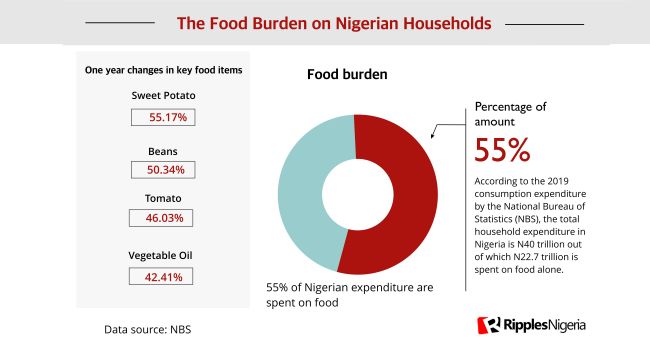Ripples Metrics
ICYMI…RipplesMetrics: Easter in 2022 is like no other, as Nigerians struggle to feed and save. (See stats)

Christians around the world are today in a celebratory mood on the death, resurrection and ascension of Jesus Christ.
The celebration, which is marked with feast and joyful gathering, is a different story in Nigeria, as essential food items go out of reach of millions of Nigerians.
According to the latest data from the National Bureau of Statistics released on Friday, food inflation in March rose to 17.20 percent compared to 17.11% in February.
The rise in the food index in March was caused by increases in prices of key food items such as bread and cereals, potatoes, yam and other tuber, fish, meat, oils and fats.
On an average, NBS had in February reported that the price of the above listed items increased by 40%. The report titled, ‘Selected Food Prices Watch,’ showed bread rose by 50 percent, potatoes by 55.17%, the highest among the food item surveyed.
Yam also rose by 39.92 percent, fish(frozen Titus) rose by 41.12%, meat(beef bone) by 29.40% while oils and fats rose by 42.41%.
States with the highest food inflation in the last one year
NBS in March listed the states with the highest food inflation as Kogi with 22.21%, followed by Cross River recording 19.86% and Kwara (19.53%).
Read also: RipplesMetrics: Despite promises, Nigeria in darkness, as govt pumps billions to power sector
Sokoto recorded the slowest rise in year-on-year food inflation with 14.04%, followed by Kaduna and Rivers with 14.66% and 14.81% respectively.
States with the highest food inflation February to March
On month-on-month basis food inflation in March 2022 was highest in Anambra with 3.78%, followed by Niger with 3.60% and Zamfara with 3.31%, while Oyo recorded the slowest rise on month-on-month inflation with -0.19% followed by Jigawa and Ekiti with -0.10% and 0.41% respectively.
Implication to Nigerians
The rising cost of food items has, no doubt, squeezed the standard of living of Nigerians. No thanks to income levels staying static.
Since March 2019, when the Nigerian Senate approved N30,000 as the minimum wage for workers in Nigeria, with some states yet to implement the law, the cost of food has soared by 27.69 percent. What this means is that the value of food N30,000 can buy has dropped by 27.69%.
This squeeze faced by Nigeria was captured clearly in a report by the Institute of Development Studies. According to the report, food now consumes about 101 percent of the average wage of Nigerians.
The report ranked Nigeria second globally where citizens spend almost all their income on food, only behind Syria where 177 percent of income is spent on food.
What next?
There seems to be no hope in sight for Nigerians, with rising cost of energy and festering insecurity threatening the country’s food baskets.
Today’s easter celebration will, indeed, be one like no other.
Join the conversation
Support Ripples Nigeria, hold up solutions journalism
Balanced, fearless journalism driven by data comes at huge financial costs.
As a media platform, we hold leadership accountable and will not trade the right to press freedom and free speech for a piece of cake.
If you like what we do, and are ready to uphold solutions journalism, kindly donate to the Ripples Nigeria cause.
Your support would help to ensure that citizens and institutions continue to have free access to credible and reliable information for societal development.


























